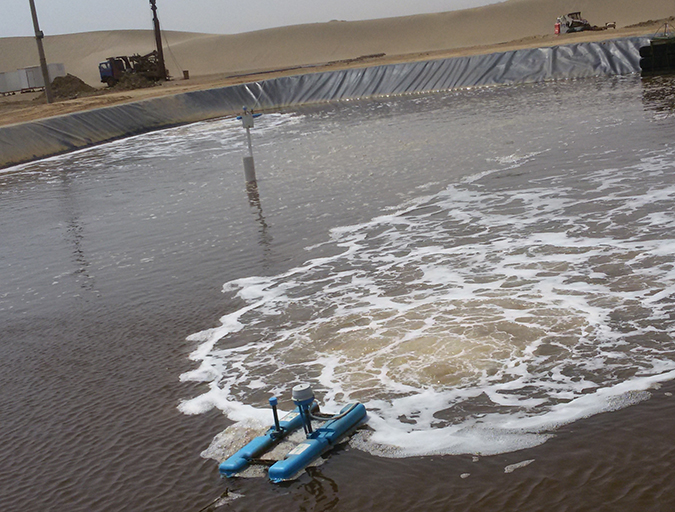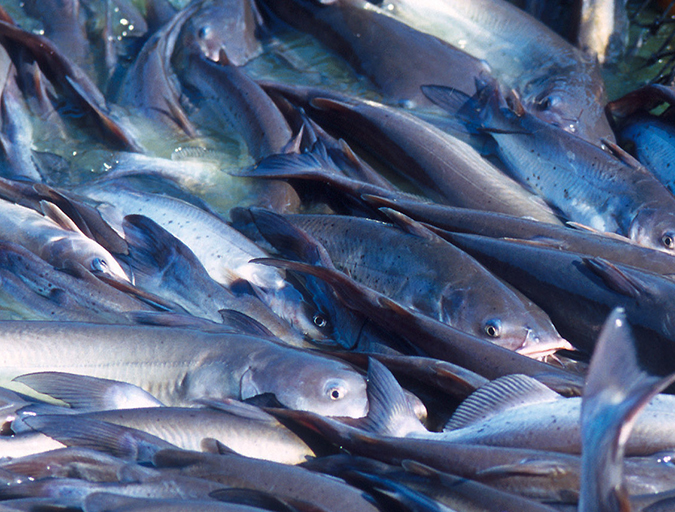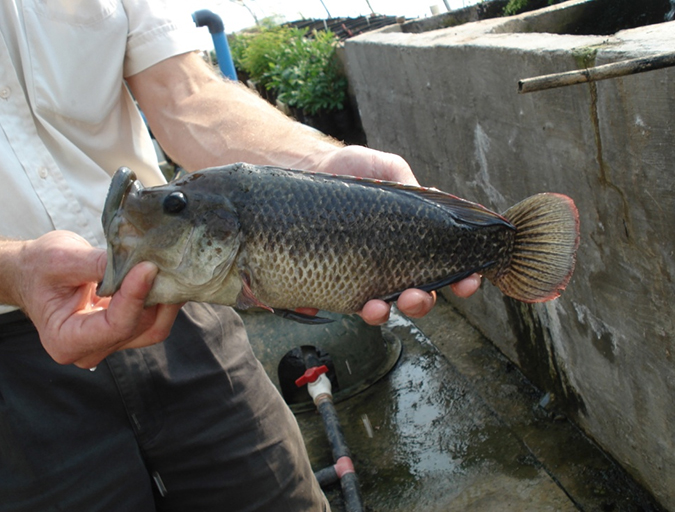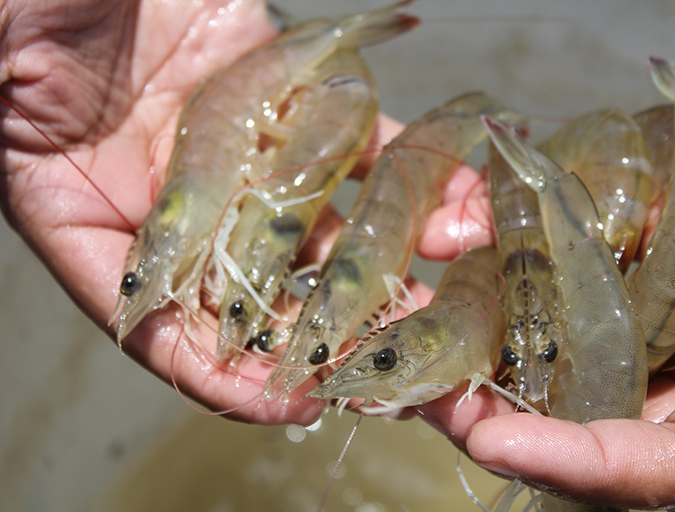Higher production efficiencies noted versus traditional ponds

The fathead minnow (Pimephales promelas) is an important baitfish species that is commercially cultured in the United States, with about 100 commercial farms producing a total of 1.5 million tons (622 million individual fish) worth nearly $10 million, per the last U.S. Census of Aquaculture in 2013.
Most commercial aquaculture production of fathead minnows is currently done in earthen levee-style ponds, with annual yields that seldom exceed 560 kg/hectare (ha) due to predation, disease, water-quality issues and other factors that combine to limit production. The species also has market potential as a feeder fish for other carnivorous ornamental and food fish species. Because of their availability and ease of culture in laboratory aquarium systems, these minnows are also widely used for toxicity studies.
Fathead minnows feed on a variety of animal, plant and organic materials found mixed in with sediments in ponds. In an aquaculture setting, even if fed a commercial diet, they still are heavily dependent on these natural foods. Based on their feeding habits, they might be a promising candidate for production using biofloc technology (BFT), which is used to improve water quality in aquaculture systems by balancing carbon and nitrogen in the system.
BFT systems recycle nitrogenous fish waste through microbial reusing of waste, and minimize water exchange. BFT systems use intensive aeration, low or no water exchange, high stocking densities, heavy mixing and high organic input, and have the added benefit of producing a supplemental feed source for some species well-suited for these conditions.
No studies have evaluated the potential of BFT for baitfish production. In our study, summarized here from the original 2017 publication (Journal of the World Aquaculture Society doi: 10.1111/jwas.12387), we tested the suitability of BFT for rearing fathead minnows for an extended period to cold temperature months, and evaluated stocking density effects on these fishes when reared in BFT systems.

Study setup
Regarding the experimental design and culture management, the study used a completely randomized design procedure to assign fish to experimental tanks. The study was implemented using 15 550-liter outdoor fiberglass tanks for 80 days. The control tanks (CS) were operated with green water without external carbon addition and aeration, stocked with 55 fish per tank (equivalent to 1 million fish/ha).
Treatment tanks simulated biofloc ponds with periodic addition of an external carbon source and continuous aeration, with stocking densities of 55, 110, 220 and 440 fish per tank (T1, T2, T3, and T4, equivalent to 1, 2, 4, and 8 million fish/ha). Fathead minnows were graded with a bar grader prior to stocking, and the average body weight (BW) used in the experiment was 0.95±0.09 g. The experiment was performed in triplicate by density.

All tanks were initially filled with pond water and make-up water was added occasionally as needed. Fish were fed twice daily with a 32 percent protein commercial diet at 4 percent BW, subsequently reduced to 2 percent BW, with a decrease in temperature from day 60 of the experiment. In the treatment tanks, glucose with a 40 percent carbon content was added to maintain a carbon-nitrogen ratio of 12:1 according to dietary nitrogen. After 80 days, gross yield, feed conversion ratio (FCR), specific growth rate (SGR) and survival (S) were determined. Individual body length and weight were measured by randomly sampling 50 percent of the total population in each tank. Data were pooled by treatment and condition factor K was calculated.
Water quality parameters (temperature, DO and pH) were measured twice daily, and water quality analyses were conducted according to standard methods using a commercial multiparameter colorimeter. Total ammonia nitrogen (TAN), nitrite nitrogen (NO2– -N), and nitrate nitrogen (NO3– -N) were analyzed weekly. Total nitrogen (TN) and total organic carbon (TOC) were measured weekly for the first two weeks and every other week afterward. Total suspended solids (TSS) were also measured weekly for the first two weeks and then biweekly. Biofloc volume (BFV) was determined on site using Imhoff cones, measured during three separate days (days 15, 43, and 71). Using TSS and BFV data, biofloc volume indices (BVI) were calculated in order to estimate the condition of biofloc.
A total of 50 fish in each tank were sampled for whole-body cortisol analysis. Sampled fish were euthanized with 100 mg/L of tricaine methane sulfonate and frozen at minus-20 degrees-C until analysis. A whole-body cortisol extraction method was applied, and cortisol extracts were analyzed with commercial cortisol ELISA kits. Statistical analysis procedures used and additional details are available in the original publication.

Results
After 80 days of experimental culture, the individual weights of fathead minnows at T3 and T4 were lower than those of the control, T1 and T2 (Table 1). Gross yields (total weights) of T2, T3, and T4 tanks were significantly higher (2–6-fold) compared with CS and T1 tanks. Although no significant differences were determined in condition factor, both FCR and SGR were significantly impaired at the two highest densities, compared with those in CS and T1 (P<0.05) tanks. The survival rate was significantly lower in T4.
| 1 million (fish/ha) CS | 1 million (fish/ha) T1 | 2 million (fish/ha) T2 | 4 million (fish/ha) T3 | 8 million (fish/ha) T4 | P value | |
|---|---|---|---|---|---|---|
| Initial total weight (g) | 52 ± 8d | 50 ± 0d | 108 ± 3c | 218 ± 13b | 413 ± 8a | 0.000 |
| Initial individual weight (g) | 0.94 ± 0.14 | 0.91 ± 0.00 | 0.98 ± 0.03 | 0.99 ± 0.03 | 0.94 ± 0.02 | 0.573 |
| Final total weight (g) | 117 ± 15d | 110 ± 10d | 213 ± 6c | 363 ± 6b | 630 ± 79a | 0.000 |
| Final individual weight (g) | 2.18 ± 0.18a | 2.19 ± 0.20a | 2.09 ± 0.11a | 1.75 ± 0.12b | 1.71 ± 0.27b | 0.018 |
| Feed conversion | 1.93 ± 0.36b | 2.07 ± 0.35b | 2.33 ± 0.11b | 3.37 ± 0.19a | 5.10 ± 1.37a | 0.025 |
| Specific growth rate (%) | 1.28 ± 0.04a | 1.29 ± 0.06a | 1.19 ± 0.06ab | 0.99 ± 0.10bc | 0.83 ± 0.21c | 0.032 |
| Condition factor | 0.91 ± 0.01 | 0.95 ± 0.06 | 0.94 ± 0.04 | 0.93 ± 0.04 | 0.94 ± 0.04 | 0.739 |
| Survival rate (%) | 97 ± 0.05a | 92 ± 0.04a | 93 ± 0.04a | 95 ± 0.07a | 86 ± 0.22b | 0.022 |
Water temperatures gradually decreased during the experiment in all tanks, and ranged from 30.5 to 0.18 degrees C. Dissolved oxygen concentrations were maintained above 6.0mg/L. Concentrations of TAN, NO2– -N, and NO– -N were not different among control and treatment tanks. The TOC and TN concentration in biofloc tanks with densities above 4 million/ha (T3 and T4) were significantly higher than the control and other treatments.
Unlike the input C:N ratio based on dietary nitrogen, the C:N ratios in culture water gradually decreased through the study period. The average C:N ratios in culture water also decreased with increasing stocking densities and feeding amount, exhibiting significantly lower average C:N ratios at the highest density (CS: 10.4, T1: 11.8, T2: 8.9, T3: 8.1, and T4: 5.3). TSS and BFV were significantly higher in biofloc treatments at densities of 4 and 8 million/ha (T3 and T4) due to the higher feeding amounts and carbon additions. The highest TSS and BFV occurred in the 8 million/ha (T4) density biofloc treatment. As BFV increased, BVI increased accordingly. And the average cortisol levels were not significantly different among control and treatments.
Suitability of BFT systems for fathead minnow production
Commercial culture of fathead minnows using BFT systems provides various advantages over traditional pond systems. For example, rearing these fishes in a BFT system can potentially eliminate losses to bird depredation. The fish mortality and subsequent reduced production due to bird predation is a regular financial loss for fathead minnow farmers using traditional ponds.
Bird predation, including from winter migratory species, is a significant source of mortality for cultured baitfish. Because of the large ponds (sometimes larger than 25 ha) used to culture these fishes, effective control of predatory waterfowl is not possible. Production of fathead minnows in tank-based BFT systems can eliminate fish losses due to bird predation, and also provide more control of various production aspects (enhanced inventory control, more efficient feeding, and facilitated harvest) versus traditional pond production systems.
Various factors can affect the efficiency of biofloc systems, but water temperature is of major importance for microbial activity and the most difficult to control in outdoor aquaculture systems. Bacteria-based water treatment systems typically thrive best at temperatures higher than those prevailing in the study, where water temperatures fluctuated broadly from 0.18 to 30.5 degrees-C. However, during the period of cold water temperatures that could reduce microbial activity, heterotrophic assimilation was sustained and kept TAN and NO2– -N concentrations within acceptable ranges at all densities. And the lowered feeding rate during the period of cold water temperatures could benefit water-quality conditions.

Commercial production of fathead minnows using BFT is not likely to replace traditional pond practices, but it is an alternative, particularly for niche markets in areas where the availability of production ponds for aquaculture is scarce. Markets for baitfish often require fish of various sizes to meet demands from different customers. In this regard, intensive BFT culture – indoor or outdoor – could provide the option for a higher degree of flexibility to respond to seasonal and/or immediate change of market demands.
Because significant capital investment will be required to start any intensive BFT culture of fathead minnows, and also because the degree of investment in such a system will depend on a variety of different factors, additional studies will be needed to evaluate the economic feasibility of BFT for commercial fathead minnow culture.
Perspectives
Results from the study indicate that BFT systems can be effectively used to increase the production of fathead minnows, established a fish density-biofloc relationship and showed that bioflocs established were able to recycle nitrogenous waste at culture densities of 4 million fathead minnows per ha. However, the study also determined that biofloc microbial biomass was not a conclusive food supplement for these fishes, and did not appear to be efficiently utilized by fathead minnows as a supplemental food source.
References available from authors.
Authors
-
Jeonghwan Park, Ph.D.
Department of Marine Bio-Materials and Aquaculture
Pukyong National University
45 Yongso-Ro, Nam-gu, Busan, 48513, South Korea -
Luke A. Roy, Ph.D.
Department of Aquaculture and Fisheries
University of Arkansas at Pine Bluff
1200 North University Drive
Pine Bluff, AR, 71601 USA -
Nilima Renukdas, Ph.D.
Department of Aquaculture and Fisheries
University of Arkansas at Pine Bluff
1200 North University Drive
Pine Bluff, AR, 71601 USA -
Trevor Luna
Department of Aquaculture and Fisheries
University of Arkansas at Pine Bluff
1200 North University Drive
Pine Bluff, AR, 71601 USA
Tagged With
Related Posts

Health & Welfare
Shrimp biofloc production trials in Saudi Arabia
An R&D trial was conducted with shrimp biofloc technology at a commercial facility in Saudi Arabia. Results indicated that biofloc technology can be effectively applied, with some protocol adjustments, in the KSA’s extreme desert environmental conditions.

Intelligence
Biofloc technology production promising in temperate zones
A study was conducted to assess the feasibility to grow Channel catfish (Ictalurus punctatus) in an outdoor biofloc system during winter in a temperate zone. High biomasses of market-size channel catfish were successfully maintained through the winter with high survival and in good condition in both treatments.

Aquafeeds
Biofloc systems viable for tilapia production
Well-designed and managed biofloc technology systems are a viable alternative for production of various species like tilapia, to increase feed efficiency by lowering aquafeed protein requirements and to help reduce or eliminate effluent discharges.

Aquafeeds
Testing shrimp growth in different biofloc systems
A study conducted with juvenile shrimp (Litopenaeus vannamei) reared in experimental biofloc systems used four treatments. Results indicate that differences in management and carbohydrate source can lead to substantial disparity in system function and production.


